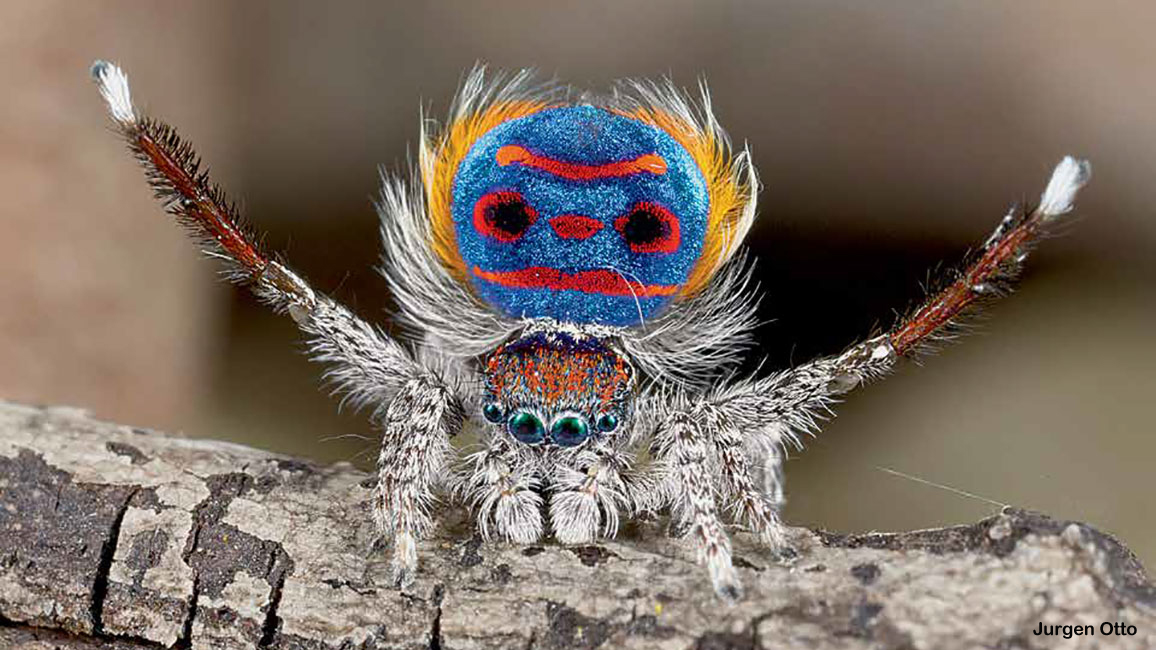
Weird Spiders
By Gerry BishopDo you think that all a spider does is sit in a web and wait to catch its dinner? Then you need to meet these extraordinary creatures!
LOOK AT HANDSOME ME!
This male jumping spider from Australia is putting on a big show. He has raised his colorful back end and two of his legs. And now he’s ready to do a little dance. What’s going on? He’s trying to win a female as his mate. You can probably guess why he’s named the peacock spider!
SPINES ARE FINE
Six hard, sharp spines surround the body of this spiny orb weaver. Do these spines protect the spider from hungry predators? No one knows for sure, but if you were a bird, would you take a bite?
Now check out those white tufts of silk on the spider’s web. They’re “flags” that may warn birds not to fly into the web by mistake and wreck it.
JUST ONE OF THE GANG
Look at the ants on the top of this leaf. Then check out the one on the underside. Ha—fooled ya! That single “ant” is not an ant at all. It’s an ant-mimicking jumping spider. (Mimic means “copy.”)
Ants taste bad to birds that prey on spiders. So this “ant disguise” is likely to send those predators off in search of tastier prey.
COME A LITTLE CLOSER
A spider assassin eats only other spiders, but spiders can be nasty biters. So when the assassin comes across a tasty spider sitting in a web, it very gently strokes a strand of the web. That lures the prey closer . . . closer . . . closer until—ZAP!—the assassin stabs the prey with its jaw-like chelicerae (kuh-LISS-ur-ee). Then it injects the prey with venom.
The victim tries to bite back. But the assassin’s “neck” and chelicerae are super long. And that allows the spider to hold its prey a safe distance away. Eventually, the prey will stop moving, and then dinner is served.
GETTING A FEEL FOR THINGS
A hungry raft spider waits patiently on a lily pad. The tips of its front legs touch the surface of the water, feeling for any movement. Finally, an insect, tadpole, or fish disturbs the surface, either from above or below. The spider feels the movement and springs into action. It races across the surface of the water and bites down on its prey. Then, like the spider shown here, it carries it back to enjoy a good meal.
JUST DROPPING IN
Imagine a little beetle crawling along the forest floor. Right above it, a big-eyed, long-legged creature hangs from a twig. Between the tips of four legs, the creature holds a net made of silk. At just the right moment, the creature drops down and throws the net over the beetle. The beetle struggles but cannot escape. A net-casting spider has struck again!
SWING BY FOR YOUR SUPPER
To catch her prey, a female bolas spider first gives off a scent that smells like a female moth. A nearby male moth picks up this scent and comes to check it out.
Big mistake! The bolas spider is ready with a one-of-a-kind weapon: a strand of silk with a sticky blob on the end. The spider swings the blob around and around until—splat!—it hits the moth and sticks to it. All the spider needs to do then is reel in her catch.
GLEAM ON
Note the shiny patches on this brightly colored mirror spider. They gleam and glitter when light shines on them—just as real mirrors would.
Scientists believe that the spider’s colors and “mirrors” might fool insects into thinking the spider is a small flower covered with shiny drops of dew. When the insects come close to feed on the “flower,” they become food for the spider!
ALL WRAPPED UP
Can you find the wrap-around spider in this photo? During the day, the spider drapes itself over a matching twig or branch. Poof—it seems to disappear! Hungry birds on their daily prowl may never spot it. At night, the spider spins a web to catch an insect dinner.
THE POWER OF POO
This crab spider looks just like a blob of fresh, wet bird poo. And what about those bits of white silk surrounding it? The spider puts them there to make the “dropping” look splattered.
This disguise does double duty. Predators ignore the spider because they have no interest in eating bird poo. But some small insects—such as the black wasp in this photo—do eat poo. You can see what happens
when they come close for a meal.
PUT ON A HAPPY FACE
It’s not hard to guess how the happy-face spider got its name! But scientists are still guessing whether the funny rear-end markings help the spider survive. One guess is that a predator that comes upon the strange “face” may be so surprised that it stops short. And that may give the spider an extra second to escape.
Now, how about this as a guess: The spider just wants to tell you how happy it is that you’ve read this story!
“Weird Spiders” originally appeared in the August 2017 issue of Ranger Rick magazine.



















